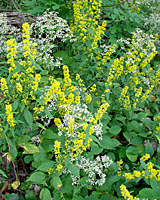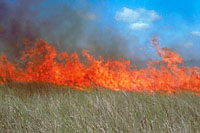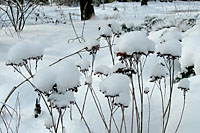Terry L. Ettinger Horticulture Consulting Services
Meeting The Needs Of Today With A Vision For The Future
Question of the Week
Cutting Back Perennials
Q. My aunts are great gardeners and have been very generous with divisions for our new home. My wife and I are new to gardening - and parenting, with three children under the age of two! Anyway, my aunts are very disappointed that we didn't cut back all of "their" perennials last fall. They've told us that if we can't keep up our garden, then they won't share any more plants with us. Will not cutting back perennials in the fall really lead to their decline?
A. If perennials aren't cut back in the fall, they won't die. So, the direct answer to your question is a flat out "no!"
Think about it?
 Wherever the perennials in your garden are native, such as the
blue-stemmed goldenrod and heart-leaf aster covering a hillside just
outside of Little Falls, New York (at left), one of three things happens to their dead stems and foliage.
Wherever the perennials in your garden are native, such as the
blue-stemmed goldenrod and heart-leaf aster covering a hillside just
outside of Little Falls, New York (at left), one of three things happens to their dead stems and foliage.
Grazing animals such as deer may browse the dead foliage back to the ground if higher quality forage is sparse. A fast-moving
wildfire might burn the previous year's leaves and stems to the ground, but leave the below ground crown and buds unharmed
(below, at right). Or,
it may simply decay,
returning
 valuable nutrients and organic matter to the soil over a
period of several months to several years.
valuable nutrients and organic matter to the soil over a
period of several months to several years.
So, as you can see, nature has figured out how to take care of itself without our constant intervention. However, some perennials will live longer and/or look better in the garden if the previous season's growth is removed prior to the new season's growth emerging.
The dense foliage of ornamental grasses, for example, is best cut back to within several inches of the ground at some point so that it doesn't smother new growth. And, the foliage of bearded irises should be cut back to eliminate overwintering eggs that adult iris borer moths lay each autumn.
Finally, a couple of words of advice.
 The dead stems, leaves and spent flowers of many perennials and
ornamental grasses can lend a "sculptural" effect to the garden
throughout the winter months - like the "mushroom cap" imitation
created by snow caught on the spent flowerheads of `Autumn Joy'
sedum, above.
The dead stems, leaves and spent flowers of many perennials and
ornamental grasses can lend a "sculptural" effect to the garden
throughout the winter months - like the "mushroom cap" imitation
created by snow caught on the spent flowerheads of `Autumn Joy'
sedum, above.
So, play with what you cut back in the fall, and what you leave intact to create different moods from year to year. And, I do mean "play!"
Gardening is supposed to be fun - not a source of additional stress in your life. So, gently tell your aunts to back off unless they want to help out in your garden. I'm sure that over time you'll find many people that will be more than happy to share parts of their garden with you. Just remember to return the favor!
Picture Credits
- Meadow Fire
- Dale Wade, Rx Fire Doctor